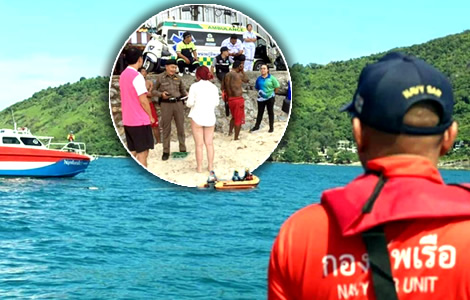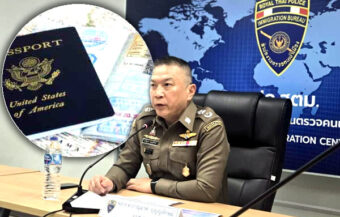Chinese tourist Yuan Wenyi’s body was recovered off Phuket’s Nai Harn Beach after violent seas swept him away Wednesday, one of two drownings that day, pushing the island’s 2025 toll to nearly 40 and highlighting the deadly risk of monsoon waters.
On Friday, rescuers recovered the body of Chinese national Mr. Yuan, who drowned Wednesday after being swept away by violent seas off Nai Harn Beach, one of two tragedies that struck within hours. The operation highlighted Phuket authorities’ commitment to tourist safety, yet this year has been deadly, with nearly 40 lost to the island’s treacherous waters, shocking officials and holidaymakers alike, proving paradise can turn lethal in seconds.

The body of a young Chinese tourist was recovered off Phuket’s Nai Harn Beach on Friday. He had been missing for two days after going swimming. Rescue operations spanned the area and involved multiple agencies and volunteers.
The victim, 21-year-old Yuan Wenyi, disappeared on Wednesday, October 1, around 2:48 p.m. He was swimming with a companion, 28-year-old Ms. Wu Haoming, near the southern Phuket beach. Authorities were immediately alerted, and a massive search commenced, led by the Maritime Enforcement Command Centre Region 3.
Vice Admiral Weerudom Muangjeen, commander of the Third Naval Area, ordered a full-scale search. Navy personnel, lifeguards, municipal staff, and volunteer rescuers were deployed. The search stretched from Nai Harn Beach to Ao Sen, extended to Ya Nui Beach, and covered waters surrounding Koh Kaeo. Teams combed coastal, rocky, and underwater zones, but for two full days, there was no trace of Yuan.
Massive two-day search for Chinese tourist swept away off Nai Harn Beach by strong monsoon currents
On Friday morning, October 3, rescue crews resumed operations along the rocky shoreline between Ya Nui Beach and Laem Phromthep Cape. At around 10 a.m., a body was spotted floating near Koh Moo, off Ya Nui Beach. Subsequently, rescuers retrieved the body and transported it to a command centre near Nai Harn Beach.
Authorities immediately renewed warnings for beachgoers. They emphasised caution during Thailand’s monsoon season, particularly in areas prone to strong currents and rough surf. Nai Harn Beach, while celebrated for its scenery, has a history of drowning incidents. The risk increases during off-peak seasons when lifeguard coverage is limited and warning flags are sometimes ignored.
Officials stated that this tragedy underlines the need for tourists to follow beach safety guidelines strictly. They also advised monitoring weather conditions before entering the water. Unfortunately, these precautions are often overlooked by visitors unfamiliar with local hazards.
Earlier on Wednesday, the man whose body was found on Friday was one of two people who drowned off Phuket’s beaches. One was an unknown national without identification at Nai Yang Beach on the northwest coast. The other was Mr. Yuan, the Chinese man at Nai Harn Beach. These incidents increased the island’s 2025 drowning toll to nearly 40. Therefore, authorities warn that even a brief lapse in judgment can be fatal.
Two drownings in one day in Phuket as the island’s 2025 toll nears forty deaths as officials warn visitors
Nai Yang Beach is located within Sirinat National Park. Its soft sand, warm waters, and scenic environment attract both local visitors and tourists seeking quieter experiences. Nevertheless, during the monsoon season, rip tides and sudden waves can sweep swimmers far from shore. Despite its calm appearance, the beach is highly dangerous.
The victim, reported as a middle-aged foreign man, was discovered unconscious on the sand at 11:19 a.m. Rescue teams transported him to Thalang Hospital. Doctors attempted CPR, but he was pronounced dead at 12:25 p.m. Authorities reported no identification, personal belongings, or visible injuries. Investigators are working to confirm his nationality and notify his embassy once established.
Only hours later, tragedy struck again. At 2:48 p.m., Chalong Police received a report of a drowning at Nai Harn Beach. Witnesses said strong waves quickly swept Mr. Yuan away. Consequently, he disappeared beneath the water. Local marine police, divers from the Phuket Kusontham Foundation, and nearby tourist and fishing boats joined the search. However, worsening conditions forced the suspension of operations until the following day.
Monsoon season proves deadly as two tourists drown off Nai Yang and Nai Harn within hours on Phuket
Nai Harn Beach, near Phuket’s southern tip, is famous for clear waters, white sand, and a scenic lagoon. Yet the southwestern coast is extremely prone to rip tides. These currents can pull swimmers out to sea within seconds. Moreover, the underwater drift can submerge victims rapidly. Authorities warn even experienced swimmers can be overpowered in minutes.
Fatalities often occur within the first five minutes of being caught in a current. Rip tides are particularly dangerous because they form quickly and are often invisible from the shore. They may appear as channels of foamy, choppy water extending hundreds of meters. Swimmers frequently struggle because they fight the current instead of swimming parallel to it. Therefore, understanding and respecting these natural forces is essential.
Phuket’s monsoon season, from May to October, intensifies the danger. Strong surf, sudden wave surges, and shifting underwater currents increase risks for swimmers. Western-coast beaches, including Patong, Karon, and Kata, are especially exposed. Uneven seabeds, submerged rocks, and debris further heighten the threat, particularly for tourists unfamiliar with local waters.
Monsoon season amplifies risk with rip tides and hidden currents that can pull swimmers out to sea instantly
Criticism has emerged over insufficient and inconsistent multilingual warnings. Red flags and lifeguards exist, but signage is sometimes inadequate or ignored. Social media has amplified concerns, calling for better signage, regular patrols, and education campaigns targeting hotels, tour operators, and visitors. Authorities are responding, but much work remains.
In response, Phuket officials introduced additional measures. Daily broadcasts of beach conditions are now made on local media. More visible warning signs have been installed. Lifeguard patrols have been expanded.
Mayor Thames Kraithat ordered a central coordination hub to support search operations and assist relatives of missing tourists. Authorities advise swimming in groups, avoiding night swimming, and strictly following flag warnings.
Officials stress that public awareness is crucial. Rip tides and strong currents can develop suddenly, even when waters appear calm. Minor misjudgments can quickly become fatal. Swimming near rocks, isolated areas, or outside lifeguard reach is particularly dangerous. Emergency responders note that most drowning deaths occur near the shore, often in narrow channels where currents are strongest. Even experienced swimmers are at risk.
Authorities expand measures and warn tourists as lack of awareness continues to contribute to deadly trend
Both Nai Yang and Nai Harn victims were foreign tourists. This highlights the importance of clear communication about local hazards. Lifeguards, emergency teams, and tour operators are working to educate visitors and ensure compliance with safety protocols.
Authorities are also reviewing staffing levels, emergency procedures, and response times on busy beaches. Past incidents are analysed to improve rescue effectiveness. Daily safety updates are broadcast on local media, and hotels are urged to inform guests about current conditions.
For tourists, Phuket’s beaches remain scenic but are not inherently safe. Rip tides, sudden waves, and shifting currents can turn a pleasant swim into a life-threatening situation. Swimming alone is extremely risky, especially during monsoon months. Even companions can be swept away, and rough conditions can delay rescue. Visitors must follow all guidelines and respect posted warnings.
The deaths of these two tourists are a stark reminder that Phuket’s natural beauty carries inherent risk. Emergency responders, tourism officials, and local authorities emphasise preparation, awareness, and caution. While the beaches are world-renowned, their waters demand respect.
Tourist deaths highlight urgent need for strict safety measures and awareness on Phuket beaches
As investigations continue, officials urge visitors to prioritise safety. Lifeguards, rescue teams, and authorities remain vigilant to prevent further tragedies. Nevertheless, the unpredictability of Phuket’s waves ensures that vigilance remains critical.
Phuket’s beaches are a mixture of paradise and peril. Rip tides, strong surf, and monsoon hazards claim lives annually. Safety depends on both local enforcement and responsible swimmer behaviour. The recent drownings illustrate the urgent need for caution and respect for the sea.
2 more tourists drown off Phuket’s idyllic but deadly beaches on Wednesday as drownings toll mounts
These two additional deaths off Phuket’s coast have renewed calls for heightened safety awareness. Understanding hazards, following red flags, and swimming under supervision remain crucial. Otherwise, the waters remain unforgiving and powerful.
The monsoon season, from May to October, marks the most dangerous period. Yet strong currents and hidden hazards make swimming risky year-round. Each incident leaves lasting grief and trauma for friends, families, and loved ones.
Wednesday’s drownings highlight how quickly a day at the beach can turn fatal. Since May, authorities have reported drowning deaths almost weekly. The popular holiday island continues to struggle with the human cost of its beautiful but unforgiving waters.
Join the Thai News forum, follow Thai Examiner on Facebook here
Receive all our stories as they come out on Telegram here
Follow Thai Examiner here
Further reading:
2 more tourists drown off Phuket’s idyllic but deadly beaches on Wednesday as drownings toll mounts
48-year-old Russian tourist drowns swimming off Karon Beach with red flags raised warning of danger


















